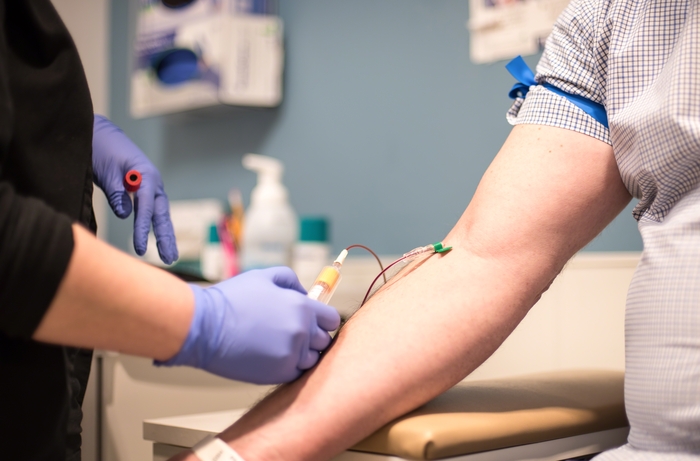
Ensure your health. Get tested today.
Convenient lab testing at your fingertips at more than 5,000 locations nationally. Consult with a doctor, or get tested on your own.

Blood tests are usually performed at every routine medical checkup, but many times, the results can be difficult to understand and interpret. Knowing how to read blood test results can empower you to take more control over your health so you can make the best lifestyle choices.
Your blood work results can reveal a lot about the quality of your health, and whether it may be causing any problems. Your blood is responsible for delivering oxygen and nutrients to all the cells and major organs in your body, which is why knowing how to understand and interpret blood test results is essential to your health and well-being.
When blood tests are reported, they can often look intimidating and confusing at first glance. However, once you learn the acronyms used for your blood test along with various blood test names and meanings, your results will make much more sense and be easier to understand.
According to Medline Plus, there are three common tests performed as part of routine health screening.. These tests include a complete blood count (CBC), comprehensive metabolic panel (CMP), and a lipid panel.
A CBC is a blood test that measures several components and features of your blood, including red and white blood cells, platelets, hemoglobin, and hematocrit. According to the National Institutes of Health (NIH), a CBC has the ability to detect and diagnose infections, anemia, immune system diseases, and blood cancers. It can also help doctors keep an eye on an existing blood disorder. Common reasons to order this test include generalized weakness, fevers, and other signs of infection.
A CMP measures 14 different substances in your blood, including glucose, calcium, albumin, bilirubin, total protein, creatine, and blood urea nitrogen (BUN). It also measures several electrolytes (sodium, potassium, carbon dioxide, and chloride) and enzymes (alkaline phosphatase, alanine transaminase, and aspartate aminotransferase). A CMP is usually performed as part of a routine checkup, or if your doctor thinks you may have liver or kidney disease, reports the NIH.
Electrolytes are minerals in your blood that carry an electric charge. These minerals play an important role in essential functions including heart rate and muscle and nerve activity. A CMP checks the levels of electrolytes in your blood including sodium, chloride, potassium, and bicarbonate. According to the NIH, abnormal levels of any of these electrolytes can indicate you have a serious health condition such as high blood pressure or kidney disease.
Bilirubin is a waste product made by the liver, and albumin is a protein made in the liver. Creatine and BUN are waste products that are removed from the blood by your kidneys. All these substances are measured in the CMP lab test, and can help your doctor determine the health and functionality of your liver and kidneys, according to the NIH.
Glucose (sugar) is the body’s primary source of energy and is moved from your bloodstream into your cells by a hormone called insulin. A fasting glucose test reveals whether you have too much or too little glucose in your system. Too much glucose could indicate diabetes, while too little glucose could indicate liver disease or a problem with your diabetes medication, according to the NIH.
A lipid panel measures the level of lipoproteins in your blood, which are substances made of fat and protein that transport cholesterol through your bloodstream. A lipid panel measures “good” high-density lipoprotein (HDL) cholesterol and “bad” (low-density lipoprotein (LDL) cholesterol. High levels of LDL can indicate that you may be at risk for heart diseases including heart attack and stroke. According to the NIH, your doctor may only perform a lipid panel if they suspect you are at risk for heart disease.
White blood cells are part of your immune system and help your body fight off diseases and infections. When you become sick, your body produces a higher number, and different types of white blood cells to fight and destroy bacteria and viruses contributing to your illness.
A WBC count measures the number of your white blood cells and can help determine whether you have a condition causing your body to produce fewer white blood cells. According to the NIH, cancer and HIV can reduce your white blood count, as well as certain chemotherapy medications used to treat cancer.
A WBC measures the number of the five different white blood cells in your body. These blood cells include lymphocytes, neutrophils, monocytes, eosinophils, and basophils. The NIH reports that neutrophils usually target bacterial infections and that lymphocytes usually target viral infections. Your doctor may examine results from this lab test to evaluate whether you can effectively fight off these types of infections based on your white blood count.
Red blood cells transport oxygen from your lungs to all the cells in your body, which helps them reproduce, grow, and stay healthy. An RBC count outside the normal range may indicate you have an illness. A low RBC count may indicate anemia, malnutrition, or leukemia, while a high RBC count may indicate dehydration, heart disease, or kidney cancer, according to the NIH.
An RBC count is usually included as part of a CBC performed during a routine medical checkup. Your doctor may also perform this test if you are experiencing symptoms of a low or high red blood count, including weakness, headache, or rapid heart rate.
Hemoglobin is the protein in red blood cells responsible for carrying oxygen from the lungs to cells. Hemoglobin is measured as part of an RBC count in a CBC. Your doctor may look more closely at your hemoglobin if it’s suspected you have anemia, reports the NIH.
A hematocrit test reveals the amount of your blood that is made up of red blood cells. Your doctor may look at your hematocrit results to determine whether you have a certain red blood cell disorder, such as anemia.
A test called the mean corpuscular volume (MCV) test measures the average size of your red blood cells. An MCV can reveal whether your red blood cells are too large or too small, which could indicate a blood disorder, reports the NIH.
Platelets, also known as thrombocytes, play a role in the formation of blood clots. Blood clots are essential to slowing or stopping bleeding, and helping your wounds heal. According to the NIH, having too many or too few platelets can indicate problems related to excessive bleeding and abnormal blood clots.
An MPV is a blood test that measures the average size of your platelets. This test can help your doctor diagnose certain diseases and conditions, including blood disorders, according to the NIH.
Blood tests are crucial because they can reveal a lot about a person's health and can identify potential health problems.
The most common blood tests include a complete blood count (CBC), comprehensive metabolic panel (CMP), and a lipid panel.
Blood tests can help detect and diagnose a variety of conditions, including infections, anemia, immune system diseases, and blood cancers.
Understanding blood test results can empower individuals to make informed lifestyle choices and manage their health more effectively.
A CMP measures 14 different substances in the blood, including glucose, calcium, albumin, bilirubin, total protein, creatine, and blood urea nitrogen. It also measures several electrolytes and enzymes.

Convenient lab testing at your fingertips at more than 5,000 locations nationally. Consult with a doctor, or get tested on your own.